| | | 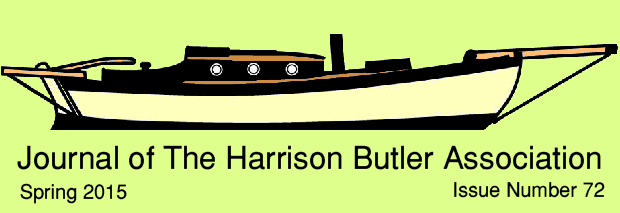
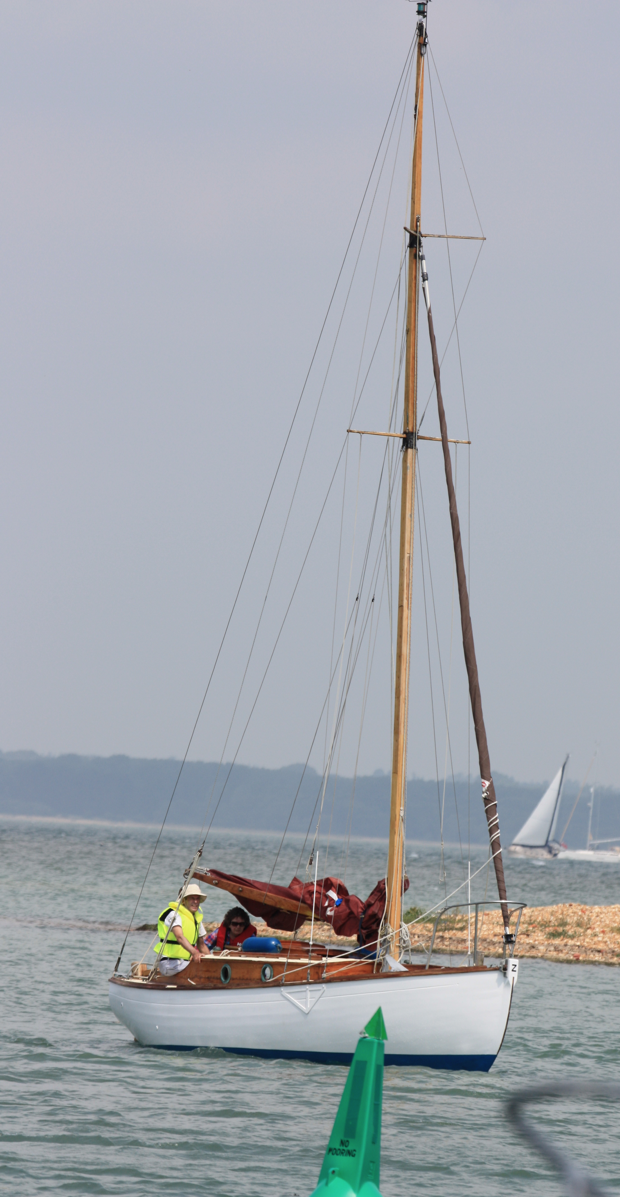
Entering Newtown River.
The Z4, Mary Gray, with skipper Tom Riddle on the helm,
motoring in at high tide to join eight other Harrison Butler vessels
for the July 2014 “Gathering of the boats.
Photograph by Martin Hansen
The Journal of The Harrison Butler Association
Editor : Martin Hansen
Proof Reading : Dr Helen Jones
Australian Correspondent : David Stamp
Contributions for the Journal are most welcome be they
fully formed articles, rough notes or snippets of News.
If you feel you would like to contribute on a regular basis,
applications to join our growing network
of correspondents are invited.

With surprise, I've realised I'm at the start of my third sailing season as a Harrison Butler'arian. I knew nothing about Harrison Butler or his boats when I bought Tramontana. The fascinating history of HB boats and the camaraderie of the associaton came as an unanticipated but welcome bonus.
What initially drove me was a desire to have a proper, heavy, sea boat. One that could be sailed single handed and which did things slowly, giving her inexperienced skipper time to think. I was insistent that the boat I bought be made of wood. Wood is adaptable, forgiving and allows for creativity in a way that glass fibre does not.
Tramontana was bought “needing cosmetic refreshing”. I quickly realised that her exterior varnish was going to be an ongoing nightmare to sort out and maintain. In consequence, I've become brutal in replacing failing external varnish with an alternative. Hammerite Direct To Rust paint is tough, adheres to pretty much anything, including directly onto old varnish, and is easy to touch up. The mottled grey is terrific for a fake galvanised look. I've used it to rescue my boat's tatty looking stanchions, pulpit and pushpit. The hammered black has a glossy sheen that is solid looking and hard wearing. I've used it to hide the unattractive rain water tarnished wood of Tramontana's cockpit seats, her bulwarks and their capping rails. Below decks I am retaining the atmospheric, traditional, varnished woodwork. Here the UK's winter weather isn't able to attack so viciously. However, behind the scenes, in the bilges and in lockers, the Hammerite white is both arresting decay and removing the fousty smell of an 80 year old wooden boat.
There are several HB boats for sale this Spring, some needing cosmetic refreshment. I don't subscribe to the view that a wooden boat has to be difficult to maintain. There are fantastic modern paint products, reasonably priced, that allow the inexperienced to get a grip on rescuing and looking after an aged wooden boat.

!•¡•! A new, fifth edition, of Harrison Butler's highly readable book about his yacht designs is to be published later this year. Lodestar Books will release the reworked “Cruising Yachts; Design and Performance” to coincide with the September 2015 Southampton boat show. For the first time, colour photographs will feature. In spite of this, the book is expected to be most reasonably priced at around £20.
!•¡•! A new build to Harrison Butler's Khamseen design of 1931 is underway in Kilrush, Steve Morris, a highly qualified boatbuilder from New Zealand, is constructing the hull with diagonal layers of Alpine larch. This is the first time this hull construction technique has been used to build a Harrison Butler boat. A light yet very strong hull will be the result.

Steve Morris and the Harrison Butler new-build to the Khamseen design.
Photographs by W M Nixon
!•¡•! Paul Leinthall-Cowman has been appointed HBA Authentication Officer. The post has been created in response to repeated attempts by owners of old wooden boats to claim that their vessel is Harrison Butler in spite of the boat being unknown to the Association, having no resemblence to any known design, and no supporting evidence being supplied to the HBA in respect of the claim. Recent examples of the malpractice include Spindle, for sale at Weir Quay Boatyard, and Serena, for sale at Boatshed Lancashire.
!•¡•! The relaunched Harrison Butler Association website is one year old. To celebrate, a new section has been added to the site; The Designs. The index page, lists all known boats by design type making it easy to look up sister boats to any given boat. Over the coming year it is intended to get each design's drawings viewable online.
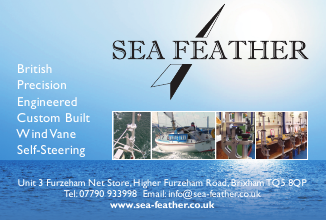
Zebedee's Story
Thomas Loos
In April 2011, Jochen Brose and I drove to the little harbour of Ballylumford, 25 miles north-east of Belfast. We'd driven 250 miles from Lough Derg in Southern Ireland and were excited about viewing Zebedee, a Harrison Butler Z4. However, our greeting in Ballylumford came not from Zebedee's owner, but from 50 officials; policemen, uniformed soldiers carrying guns, and paramedics. The harbour was cordoned off due to an investigation into “suspicious activity”. A mighty crane, under the military's control, manouvered ominously in the background.
Eventually, having promised we would only look at Zebedee, we were allowed inside. When the owner, Desmond, arrived we had already fallen in love with the boat. After haggling, a deal was struck. In the meantime the crane lifted a car from beneath the harbour waters, a dead body inside.
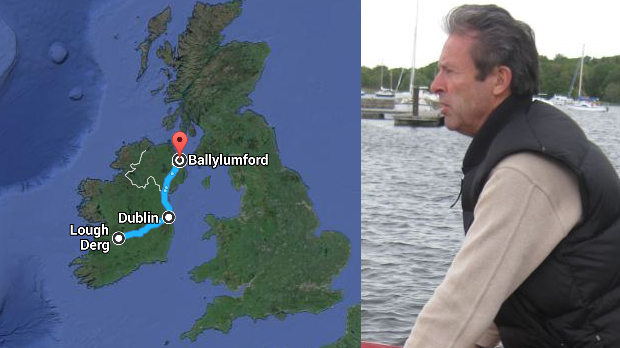
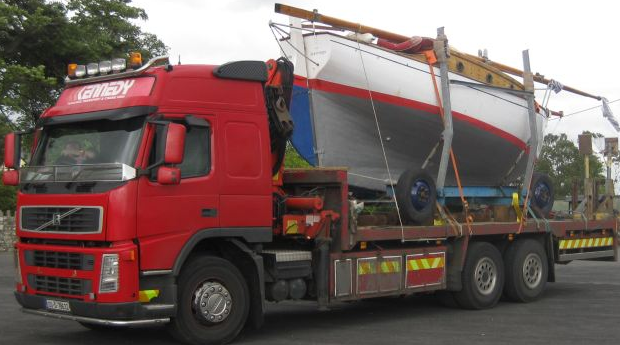
Jochen Brose & Thomas Loos (pictured) had Zebedee transported 250 miles
by road from Ballylumford to Lough Derg, a lake in Central Ireland.
Two weeks later a low loader arrived in Mountshannon, where we lived on the banks of Lough Derg, with Zebedee on its back. She was craned into the harbour. To our relief she was totally watertight despite having been on the hard standing at Ballylumford for a couple of years. As the ancient engine wouldn't start, we arranged for a tug to tow Zebedee to our nearby mooring. The tug missed the centre of the narrow exit from the harbour and I had to leap into the water to push Zebedee away from a threatening rock.
We never did get that engine to run, and eventually swapped it for a 9 HP Farymann Diesel. Being without a working engine didn't stop us having fun with the boat. We simply had to wait for the right wind to be able to sail in and out of the harbour. I remember the first of our engineless voyages. A forecasted Force 3 became a Force 8 within half an hour of us setting sail. Pleasingly, we coped with this, managing to reef Zebedee right down and get the storm jib up. It was a steep learning curve that day, but we emerged from it having confidence in ourselves and the boat.
Over the next winter we repainted the hull above the water line and got her surveyed. The surveyor claimed that he had never seen a boat of that age in such good condition; a strong testament to the two previous owners who had put a lot of hard work into her.
Sadly, our non-boating lives have become too hectic to allow us to properly enjoy sailing and working on this beautiful boat. So, four years on, and after many other adventures in her, we are putting Zebedee up for sale - with a working engine!
My Other Boat
David Stamp
The HBA's Australian Correspondent

David Stamp, who owns Amiri, has built an Iain Oughtred designed skiff.
He's sent in a couple of photographs of the sea trials.
“The first is a study in tangled oars, but after adjustment of their inboard lengths
to reduce their overlap, the technique improved”.
The Gathering Of The Boats 2014
From Tramontana's Log
2014 : July : 11th : Friday
Under engine, Mike and I piloted Tramontana out of Haslar Marina at 4 am into a calm and windless Solent. Five hours later we were attached to N°2 buoy on the Newtown River. We were the first to arrive. At lunchtime, Askadil sailed in and, a little later, Cobber followed by Lindy II. Carefully, Cobber worked her way up a narrow channel to a visitor buoy on Clamerkin Lake whilst Lindy II rafted up to us. Robert & Mandy Griffiths invited us aboard for tea and biscuits. Their boat is a varnished beauty; in immaculate condition both above and below decks. They introduced us to their cute dog, Flint, named after the Captain in Treasure Island.
As evening fell, Mike and I launched Tramontana's tender and rowed over to Askadil where Simon & Penny Richardson invited us aboard. This was Askadil's first sail in twelve years. The Richardsons are highly experienced sailors who had taken Askadil across the Atlantic prior to their twelve year break from sailing. I did my best to learn as much as possible from their relaxed, welcoming and enthusiastic nautical conversation, for they were clearly delighted to be afloat once more.
2014 : July : 12th : Saturday
On a rising tide, more Harrison Butler designed boats arrived. John-Henry, the Chairman of the Harrison Butler Association, and his wife Marilyn, used Cobber's tender to visit us on Tramontana. They marvelled at the fact that Tramontana had two sinks in her galley, clearly surprised at how spacious Tramontana was compared with Cobber, their Z4. At noon on a sunny, warm day all crews made their way to the nearby beach for a BBQ. Robert Griffiths, who had organized the event, was clearly delighted when Vindilis unexpectedly sailed in. She took the total number of boats attending to nine, the most numerous gathering of Harrison Butler designed boats for many years. The final roll call was; Askadil, Caracole, Cobber, Lindy II, Little Kingfisher, Mary Gray, Sabrina, Tramontana and Vindilis.
I spent the evening aboard Sabrina with Craig and Kate Nutter, and Richard and Helen Framer (from Vindilis). A leg of lamb was being roasted aboard Little Kingfisher, which was rafted up against Sabrina. With the resulting mouth watering aroma as backdrop, salty tales were told, wine drunk and snacks consumed. On Little Kingfisher, Hannah and Dan tended to their new born child, Alexandra, periodically checking on the roasting lamb and on how the party next door was progressing. At evening's end I rowed Richard and Helen back to Vindilis not quite appreciating that it was against a strong current all the way. Exhausted and full of wine, I slept well that night.
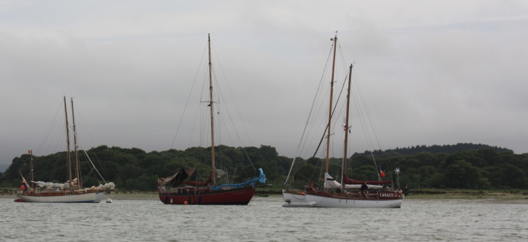
Red hulled Tramontana, surrounded by four other
Harrison Butler designed boats on the Newtown River.
For more photographs, visit the gallery.
2014: July : 13th : Sunday
A cry of alarm at 10.15 am brought me scurrying up from below Tramontana's decks in time to see Cobber execute a couple of high speed turns. She was in pursuit of Caracole's unmanned tender that was being carried swiftly away up Newtown River on the flood. It was a valiant rescue attempt, abandoned at the last moment as the tender was swept over a shoal that would have seen Cobber aground had she followed.
From Caracole a youthful figure dived in, swam after the tender, caught up with it, and hauled himself aboard. Then, to much applause from the watching crews of the other boats, Terry Musgrove rowed it back to Caracole.
How had Terry known there were oars aboard with which to row the tender back? It transpired that it was he who'd let the tender's painter go whilst untying it, getting ready to hoist it aboard Caracole. So, losing the tender would have been an own goal but for the beautiful save !
The entertainment over, Mike and I slipped our mooring at 11 am. The in-flow of sea had by then made it deep enough for Tramontana with her draught of 7' 3" to exit Newtown Creek. Once in the Solent we zipped about under engine to take pictures of Askadil and Cobber under sail. We then raised our own sails, turned the engine off, and enjoyed a four hour wind-powered ride to Lymington Marina.
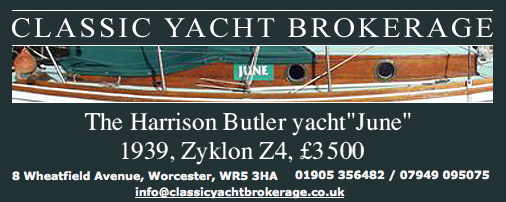
Mad-Cap Voyage
Edwin Danson
The handsome youth in the photograph is me, aged 16, taken in 1964 when Fleetwing was having her annual 'spruce up' in Iverson's boatyard, Dover. The joint owners at the time were Messrs Brown and Dyer, an unlikely pair. Jim Brown was, I recall, an architect with the local council, and Dyer a London accountant. My maths tutor was a keen sailor and it was he who introduced me to Jim Brown in 1963 as someone looking for a caretaker for his cutter. The deal was simple: keep Fleetwing in shape, clean and painted, and deal with the boatyard, in return for sailing and membership of the Royal Cinque Ports Yacht Club. To help me do this I recruited a school friend as master carpenter.
Brown (who seemed to be the money) had deep pockets but short arms; the old boat was ever desperate for TLC, and paint and varnish that wasn't thinned 50%! Anti-foul was applied as if it were gilt - sparingly. I recall the engine; petrol and a bitch to swing. When it did eventually fire up (many blisters later), the cabin quickly filled with fumes so the hatch and doors always had to be kept open. Fleetwing was persistently damp; one would air the bedding and ancient lifevests only to find them all damp again the following week. The interior was always musty.
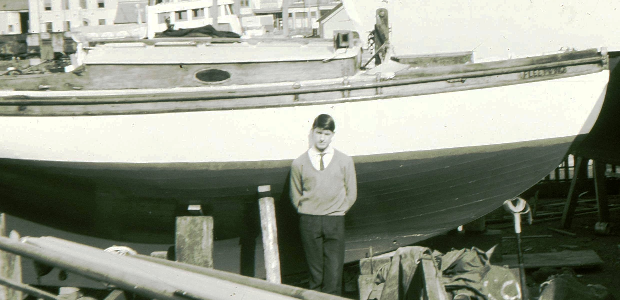
My most memorable voyage in Fleetwing took place in July 1964, Boulogne being the intended destination. The forecast was not what one would wish for in summer and so Brown, who was a fair-weather sailor, elected to skipper from the members' bar. This left Fleetwing under the command of S Dyer, Esq, a somewhat overweight and nervous character that my school friend and I seldom saw.
The first leg was more or less due south, Dyer having decided to head from Dover to Boulogne in a straight line. This took us through the overfalls of the Varne sand bank. On the chart, the minimum depth was 6 feet, and so Fleetwing's draught of 4 feet, in theory, gave us a worst case scenario of 2 feet of water under the keel. I recall panic in Mr Dyers eyes and bad language as we unhealthily bumped on the sand at each wave's trough. Fleetwing had no radio and the flares carried were long past their sell-by date. We were twelve miles from both the English and the French coastline and on a boat that was being rhythmically pounded apart.
Somehow, Fleetwing held together until we'd passed over the sand bank. Not so Dyer's nerves and we were instructed to change course and make for the nearest port, Calais. It was early evening when we tied up in the tidal basin there. We found a bar where we spent the evening listening repeatedly to Louis Armstrong singing Hello Dolly on the juke box.
Next morning, Sunday, was gusty, grey and the sea had a lively chop. Dyer had to get back to London and my colleague and I had school. So, after breakfast, off we went. The weather worsened and the voyage turned miserable; the only food we ate was a couple of tins of cold beans. The Varne sand bank was given a very wide berth! I can still recall the overwhelming relief of passing through the western entrance of Dover harbour.
Since this voyage, the tune Hello Dolly has always caused me to involuntarily think of bumping along over the sand bank, Fleetwing's musty smell, her unreliable engine and cold baked beans.
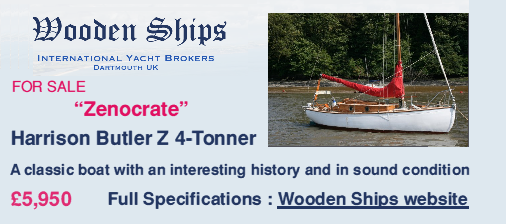
In Tribute to Geoff Taylor

Geoff Taylor photographed by Patric Burgess
Geoff Taylor died in August last year. He was well known amongst the Association's membership for his multiple crossings of the Atlantic in Watermaiden, a 30 foot wooden boat built in 1939 to Harrison Butler's Rose of Arden design. From England the typical voyage across the Atlantic heads south to the Canary Islands and then west using the trade winds to get to the Caribbean. To return, a route much further north catches the stream of depressions moving from west to east, from USA to UK. Written by Geoff in June 2004, the following article is interesting because Geoff, having previously done the Atlantic the conventional way, decided to fight his way up from Gibralter to Plymouth, going against the average flow of the wind, and against the clockwise circular current of the Atlantic Ocean.
A Cruise Home
Geoff Taylor
The cruise home to Plymouth from Ayamonte, a Spanish town 2 miles inland on the River Guardiana, took 28 days. Let's dwell on that for a moment: 28 days - that's double the average time taken to do the same route the other way round. There was no sense of slowness to begin with, however, for my voyage began with a swift passage along the Algarve coast thanks to a brisk easterly blow. The joy of racing along, however, vanished as I rounded the Cape Saint Vincent. Progress from then on was hindered by light winds, often blowing from the direction I wished to head in, and calms. In addition, long rolling seas coming in from the west made it an uncomfortable business working my way north of north-west.
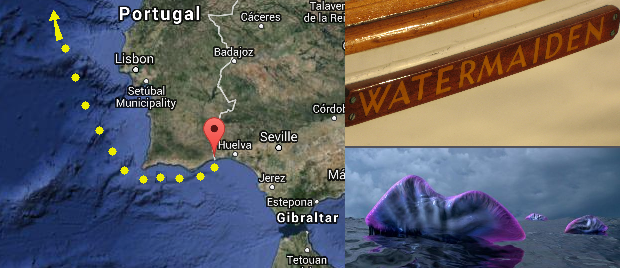
During the calms I saw small crabs, a couple of inches across, swimming near the surface. For a week I became surrounded by thousands of small Portuguese man o’ war. I have, in the past, often seen full sized specimens of this jellyfish for they are a regular feature in summer out near the Azores. But I'd not seen the young before. A highlight during the slow voyage north came when a large whale surfaced alongside. After a few magical moments it submerged and did not return. That is the third time I have seen a whale on this coast. It could well be the sole inhabitant of the area, perhaps checking floating objects in case they may be family members or friends.
By the time I got to the latitude of Lisbon the wind had gone ahead and I was forced offshore until I was about 100 miles west of the coast. Although not part of the plan, this was advantageous as it kept Watermaiden clear of shipping and unpredictable shore weather effects. A long awaited change in the wind's direction then enabled me to head to north for about five days which brought me 60 miles north of the north coast of Spain and 450 miles in a direct line from Plymouth.
Alas, having reached what should have been a favourable position, winds from the north-east sprung up. Thoughts of a quick run home evaporated. However the head-winds were not strong so I took the starboard tack to make northing. Then as the wind slowly veered over the next few days my north-westerly course gradually swung round to north of north-east. My tactics paid off as a westerly settled in and progress became swift due east all the way to Plymouth. This concluding sprint home was most exhilarating; sailing at its best.
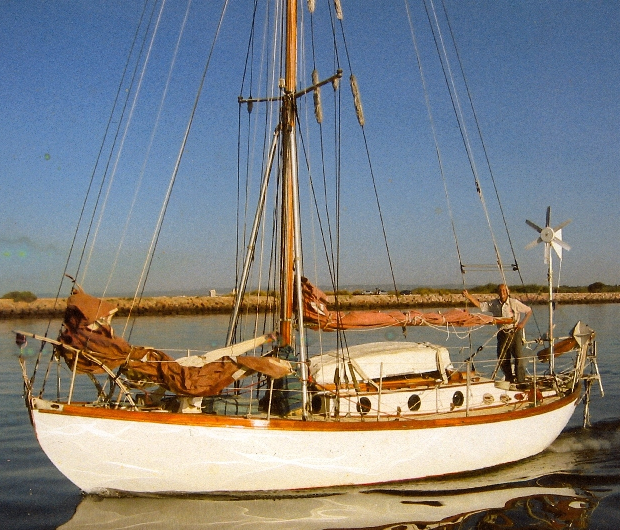
Geoff Taylor aboard Watermaiden

Almonde : Englyn Design : 1934 : Netherlands : £31,000
Chiquita : Z4 : 1939 : Devon, UK : £2,700
Cyclone : Cyclone Design : 1941 : Netherlands : £11,000
Diana : Cyclone Design : 1928 : Solent, UK : £7,500
Fleetwing : Seagull Design : 1913 : Essex, UK : £2,000 Update, 15th April, SOLD
Jane : Bogle Design : 1939 : Cornwall, UK : £10,000
Jolanda : Omega Design : 1996 : Germany : £25,000
June : Z4 : 1939 : Scotland : £3,500
La Bonne : Nursery Class : 1919 : Devon, UK : £POA
Senorita : Cyclone II Design : 1934 : New Zealand : £4,000
Tamaroa : Thuella Design : 1973 : £9,000
Thule : Yonne Design : 1934 : Netherlands : £15,000 -£18,000
Watermaiden : Rose of Arden Design : 1939 : Cornwall, UK : £17,500
Witte Walvis : Z4 : 1939 : Netherlands : £5,000
Zebedee : Z4 : 1938 : Ireland : £4,750
Zenocrate : Z4 : 1938 : Devon, UK : £5,950

| |